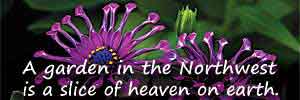Fuchsia corymbiflora
PERUVIAN BERRYBUSH, VINE FUCHSIA
syn. F. boliviana, F. corymbosa
Family: Onagraceae
Pronounced: FEWK-see-ah (Most people pronounce it FEW-shah.) kor-im-bih-FLOOR-uh

Quick Jumps
Growing Guide
Rainy Side Notes
GROWING GUIDE

Origin:
Bolivia, Colombia, Ecuador, Colombia, Ecuador and Peru.
Plant Group:
Shrub or small tree.
Hardiness:
Sunset zones: 17, 22-24.
USDA zones: 10; possibly hardy in zone 9.
Mature size:
Height: 12 feet (4 m).
Width: 3-4 feet (1-1.2 m).
Flowering period:
Summer until first frost.
Flowering attributes:
Terminal racemes of red, tubular flowers with reflexed red sepals and scarlet petals followed by 1-inch long pinkish-red edible, tasty fruit. The flowers are hermaphrodite, with both male and female organs.
Leaf attributes:
Up to 8-inch long, elliptic, soft hairy leaves.
Light:
Partial shade.
Soil:
Fertile, moist, well-drained soil.
Feeding:
Fuchsias are heavy feeders, thus monthly applications of a complete organic fertilizer, from spring through July, is called for when growing in the ground. In containers, you may want to use a slow release fertilizer. If leaves turn yellow, this may be a sign of the plant needing more nitrogen. Be careful not to over feed as this could burn the plants in containers when using a chemical fertilizer.
Propagation Methods:
Sow seed as soon as ripe and germinate at 65-75°F (18-23°C); germination will occur in approximately 6 weeks. Pot up individual seedlings and grow on in a warm greenhouse over winter. | Take cuttings throughout the growing season.
Pruning Methods:
Can be pruned hard.
Pests and Diseases:
Whitefly, aphids, scale, mealy bugs and spider mites may be problems for this fuchsia. Resistant to fuchsia gall mites, a problem in California, but not in the Pacific Northwest.
Rainy Side Notes

Fuchsia, named after Leonhart Fuchs (1501-66), a German herbalist and physician, is properly pronounced — FEWK-see-ah. However, English-speaking people pronounce it FEW-shah. If you pronounce it correctly, you could receive either a blank stare as they wonder what you are talking about or a sideways glance as they think how weird you are to pronounce it so funny. Its epithet — corymbiflora — combines two words, corymb from the Latin corymbus, meaning a bunch of flowers and flora, meaning flowers. In Roman mythology, Flora was the goddess of flowers.
I ordered this fuchsia in 1998 and received it tagged as Fuchsia excorticata. I was not familiar with the species but was intrigued enough by the description to want to try it in my garden. I planted it out, anticipating a tall fuchsia with peeling bark. The next two winters killed it back to the ground, but it came back each spring and grew fast to about four feet tall. Someone pointed out to me that it was not F. excorticata and thought instead that it was a tender South American plant. I dug it up and imprisoned it in a container, not wanting to lose the fuchsia with the beautiful trailing red flowers. I wintered it over in the greenhouse from then on.
After some time, I was able to correctly identify it as F. boliviana, a tall shrub to small tree native to the western part of South America. It was fortunate that its initial planting in the garden provided enough protection for it to survive, and two consecutive mild winters further aided its resilience.
Despite the mistaken identity, this striking fuchsia I continued growing it as a container plant. The vibrant red, tubular flowers exude an exotic, tropical charm.
In its native haunts, the fuchsia can grow as high as twelve to fifteen feet under a cool canopy of a maritime forest, with weather consisting of constant cloud cover and no freezes.
The plant flowers continuously from July well into fall, sometimes longer in the greenhouse.
Peeling bark and eight-inch long, soft, hairy leaves adorn this frost-tender shrub. The local hummingbirds pollinate racemes of the elegant, long tubular, bright red flowers that ensure a crop of large, tasty, dark purple fruit with a mild flavor reminiscent of ripe figs. In South America, you can buy fruits in the marketplace. This fuchsia prefers cooler climates and languishes in heat. On the same continent, F. corymbiflora grows along stream banks and other moist conditions in high elevations where a regular cloud cover keeps the climate cool.
Debbie Teashon
Photographed in author's garden.

Gardening for the Homebrewer: Grow and Process Plants for Making Beer, Wine, Gruit, Cider, Perry, and More
By co-authors Debbie Teashon (Rainy Side Gardeners) and Wendy Tweton
Copyright Notice | Home | Search | Perennials

